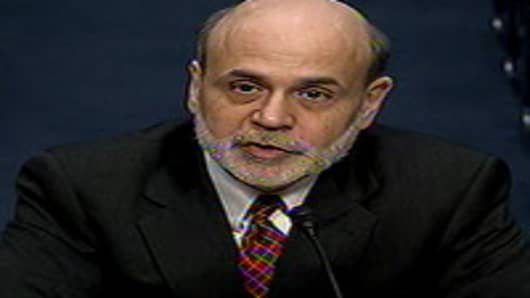Fears over the continuing European sovereign debt crisis and weaker than expected economic data from the US helped to push the price of US Treasurys up and take yields to a six month low on Thursday as investors looked for safety.
The yield on 10-year Treasury notes stood at 3.068 percent on Friday, having hit a six-month low near 3.053 percent on Thursday. Investor fears were stoked by first quarter GDP figures in the US, which were not revised up as had been expected confirming the economy grew by 1.8 percent versus market expectations of 2.1 percent.
US unemployment claims also shot up by 10,000 to 424,000, from 414,000 the previous week, while the increase in consumer spending was revised down from 2.7 percent to 2.2 percent.
All this set the tone for a hectic day of bond buying with investors rushing to buy safe haven bonds on fears that the US economy has hit a soft patch.
Ajay Rajadhyaksha, co-head of U.S. fixed-income strategy at Barclays Capital said in a research note Friday morning that: “US stock and bond investors have turned a little cautious, with rates rallying slightly and equities down a little on the week. Soft data (including weak Q1 GDP print and higher jobless claims) and European sovereign issues are the main market movers.”
Rajadhyaksha added that, for now at least, investors were ignoring Congress’ inability to reach an agreement over the raising of the debt ceiling. However, he warned that investor sentiment will change the closer to the August 2 deadline the Republicans and Democrats get without agreement.
Jeremy Batstone-Carr, strategist at Charles Stanley, told CNBC.com that bond buyers had begun to take the view the US economic recovery was stalling, meaning interest rates were unlikely to rise, while the imminent end of the second round of quantitative easing (QE) in the US was beginning to feed into fears over the extent to which the Federal Reserve Bank was propping up US treasurys.
However, he said the notion overseas investors were seeking a safe haven from the European sovereign debt crisis by buying US treasuries had been undermined by data released overnight, which showed that overseas investors had actually sold more US treasurys than they had bought on Thursday.
While Batstone-Carr accepted Rajadhyaksha’s view that investors had yet to price in the failure of the Republicans and Democrats to reach an agreement over raising the debt ceiling, he added: “It is a very live issue. There’s a drop dead date of August 2 and that’s a very hard deadline. It’s not like the May 16 deadline, after August 2 unless a decision is reached the US is effectively bankrupt.”
“Politicians are taking the view that if the markets are not worried, why should they be, but markets are biding their time on this issue and there is potential for more volatility as August 2 approaches,” he added.
Added to these concerns is the fact that fiscal austerity is likely to form the basis for any deal on the debt ceiling. According to Rajadhyaksha, only “the magnitude and the method (tax increases versus spending cuts) is up for debate.”
And such a programme of fiscal austerity could have significant implications for US growth, he added.
Rajadhyaksha said if the US followed the UK’s example - however unlikely that might currently appear to be - it would mean a cut in debt/GDP forecasts of between 5 and 6 percent from previous forecasts, which could have a substantial effect on growth in future years.
Moreover Bill Gross, founder, managing director and co-chief investment officer of PIMCO, is now short US treasuries. Gross told CNBC the firm was "very underweight" the U.S. treasurys market but said it was a "misconception" the firm was short the bonds adding PIMCO had bonds that were doing better than treasuryssecurities.
But PIMCO's website in May showed its $240 billion Total Return fund was short U.S. government-related debt including treasurys, TIPS, agencies, interest rate swaps, Treasury futures and options, and FDIC-guaranteed corporate securities.
All of this led Batstone-Carr to conclude the Gross was sending a clear message to investors: that the US economy is falling back into recession.
Batstone-Carr pointed to a recent interview Gross gave to Morningstar, in which he said: “It's hard to know how much treasury yields have been suppressed by the Fed's buying up of treasuries and incentivised others that we spoke to in terms of the Chinese.
“But let's say at least 50 to 100 basis points. So it’s a valuation issue, but it's also a recognition that at least in terms of policy-rate terms and money market terms we’ve reached a zero bond.
“I mean no one would dispute that. We can have legitimate argument and disagreement, but you can’t go lower than zero, as Japan has found out for the last 10 years.”
According to Batstone-Carr, PIMCO’s position is not unique but it is unusual.
“It’s unusual for them to take such a substantial bet. It has stopped being an investment bet and is becoming a political comment,” he added.
What seems apparent is the US, and as a consequence markets in geneal, are in for a bumpy ride. Batstone-Carr suggested that the Fed could copy the Bank of England by ending QE but leaving itself the option to reintroduce at a later date, should it become necessary.
That, he suggested, might well be exactly what is happens.
“The US simply has no choice but to continue with QE. It has got to continue issuing debt into the market,” he said.
While he conceded it may be hard to convince sceptical politicians of the need for more QE, Batstone-Carr added: “The Fed could do nothing positive, nothing benign or helpful in order to create a mini crisis and make QE necessary. If we were to see a 5 to 10 percent fall in equities that would be enough for the Fed to say it had to follow unconventional policy.”


